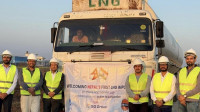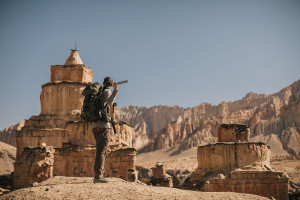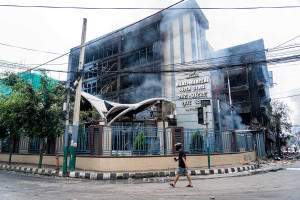Money
Everest base camp to have high-speed connectivity
Ncell plans to build five BTS towers in Thame, Somare Pari Hill, Dingboche, Thukla Hill and Pyramid Hill to provide 4G telecommunication service.
Krishana Prasain
Private sector telecommunication company Ncell is building the world's highest cell phone tower at an altitude of 5,200 metres on Mt Everest, which will provide dedicated ultra fast 4G connectivity, officials said.
The company will erect base transceiver stations (BTS) in at least five locations in the Everest region, ranging in elevation from 3,830 to 5,204 metres above sea level, to serve mountain communities.
“If things go as per our plan, we will have our 4G live in the area by the fourth quarter this year,” Ncell told the Post in an email.
“Access to high-speed mobile broadband in the area will support multiple sectors including tourism. With 4G access, people from remote areas of the Everest region can take advantage of the opportunities that high-speed mobile connectivity brings. Tourists can share the excitement of their visit to the region and stay connected with their loved ones,” it said.
“Once there is reliable connectivity, it contributes to creating innovative experiences for consumers, adding values for the tourism sector.”
On March 14, the Ministry of Forests and Environment issued a seven-day notice inviting feedback on the environmental impact assessment (EIA) report of the project entitled BTS Sites for Everest Base Camp Trekking Route.
"The purpose of the announcement is basically to make project documents public and obtain comments and suggestions," said a joint secretary at the Ministry of Forests and Environment. “The approval of the EIA depends on how it has addressed environmental impacts.”
If the EIA process is successful, it identifies alternatives and mitigation measures to reduce the environmental impact of a proposed project.
According to the EIA, the project will last three months, and after 4G service becomes available in the Everest region, there will be a tremendous improvement in mobile service with the highest mobile internet speed and broadband network availability.
According to Ncell, an initial report has shown that 4G signal can be received on the Everest summit at 8,848.86 metres. It said the exact result would be known after the test is successful.
Everest base camp already has 4G service but there is no dedicated infrastructure.
Improved internet service will also help in disaster risk management and minimisation as the Sagarmatha or Everest region is located in a geographically remote area, the report said.
The Everest region receives nearly 60,000 trekkers and mountaineers annually. It is a high revenue generating segment of the tourism industry because of the allure of the world’s highest peak.
Everest climbers need to spend $35,000 to $90,000 per person depending on the extent of support needed in terms of guides and supplies. This amount includes the cost of the climbing permit of $11,000.
China has successfully tested 5G at the base camp on the northern side of Everest. The study began in April 2020.
“In the old days, climbers and trekkers used to carry satellite phones, which were expensive and required permits,” said Ang Tshering Sherpa, former president of the Nepal Mountaineering Association. “It was a big hassle.”
With 4G service, communication up to the summit will be enhanced. Foreign adventure seekers will not be the only ones benefiting from this scheme. It will also create a positive impact on locals in the remote mountainous region, particularly in search and rescue efforts.
“Indeed, it's welcome news,” said Sherpa.
The EIA report said that the fastest internet service available will also bring a positive impact on the conservation of Sagarmatha National Park.
"The expansion and level uplift of mobile telecommunication technology will increase the effectiveness of public services," the report said, adding that it would also improve the infrastructure by increasing the capacity of the service and facility. The plan will help to encourage the use of mobile telecommunication in the area.
The proposed project will be implemented in Solukhumbu district of Province 1, Khumbu Pasang Lhamu Rural Municipality Ward Nos 4 and 5. The project will cover 753.55 square metres of Sagarmatha National Park.
Five BTS towers 7 metres in height will be erected. They are planned to be built in Thame, Somare Pari Hill, Dingboche, Thukla Hill and Pyramid Hill.
According to the EIA draft, 27,495 users will be able to use the service per hour with each tower serving 5,499 users per hour. The service will be available 24/7 and four out of the five towers will be powered by solar energy.
The project site in Thame will be managing electricity produced by Khumbu Electricity Company.
Each BTS tower will be equipped with a 1,000 ampere hour battery, and 33 solar panels will be installed at each site to produce power.
Ncell Axiata Limited (previously Ncell Private Limited) has a 16.84 million customer base with 8.34 million mobile broadband users in Nepal. Among its 14.48 million users, 6.14 million are 4G users. Ncell has extended 4G to all seven provinces.
Currently, Ncell provides 2G and 3G services in Namche Bazaar, Thamu, Thyangboche, Gorak Shep, Everest View Hotel, Khumjung, Phakding and Lukla.




 9.12°C Kathmandu
9.12°C Kathmandu













%20(1).jpg&w=300&height=200)
